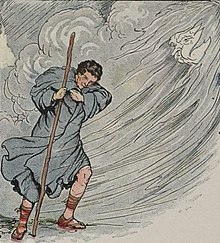
Back تجسيد Arabic Увасабленне Byelorussian Увасабленьне BE-X-OLD Олицетворение Bulgarian নরত্বারোপ Bengali/Bangla Personificació Catalan بەکەسکردن CKB Personifikace Czech Personifikation German Personification English


Personification is a figure of speech where non-living objects are described to seem like people.
For Example: "O Rose, thou art sick!" by William Blake[1]
Meaning: Blake personifies the rose as being sick, illustrating the theme of decay and corruption.
In the arts, personification means representing a non-human thing as if it were human. Personification gives human traits and qualities, such as emotions, desires, sensations, gestures and speech, often by way of a metaphor.
Personification is much used in visual arts. Examples in writing are "the leaves waved in the wind", "the ocean heaved a sigh" or "the Sun smiled at us". In easy language personification is just giving an example of a living being for a non-living thing. "The wind shouted". In these examples, the nonhuman subjects are given human characteristics.
Another commonly used personification is found in stories where animals and legendary creatures are attributed labels for recognition. This is called anthropomorphism.
- ↑ Mulyati, Sri - (2019-09-09). "THE ANALYSIS OF FIVE WILLIAM BLAKE'S POEMS". Wanastra: Jurnal Bahasa dan Sastra. 11 (2): 113–120. doi:10.31294/w.v11i2.5414. ISSN 2579-3438.